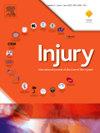Demographic trends of boxing-associated fractures over 10 years
IF 2.2
3区 医学
Q3 CRITICAL CARE MEDICINE
Injury-International Journal of the Care of the Injured
Pub Date : 2025-02-01
DOI:10.1016/j.injury.2025.112154
引用次数: 0
Abstract
Background
Boxing is a sport well-known for the risk of injury. However, the epidemiology of boxing-associated fractures has not been well studied. This study aims to report the characteristics of boxing fractures that lead to presentation to the emergency room and evaluate the demographics and practices of the patients to prevent these injuries.
Methods
This cross-sectional study analyzed boxing-associated fractures over a decade (2013-2022) using the National Electronic Injury Surveillance System (NEISS) database. Patients presenting to U.S. emergency departments with boxing-related injuries were categorized by age, gender, and injury location. Descriptive statistics, chi-square tests, and ANOVA were employed to assess temporal trends and associations between injury occurrence and demographic variables.
Results
Analysis of 959 boxing-associated fractures (BAFs) showed that hand fractures were most common (53.64%), followed by phalanx (12.73%) and facial fractures (10.91%). Significant differences were observed across body parts (χ2 = 9.74, P < .001). Associated soft tissue injuries included lacerations, contusions, sprains, strains, and hematomas, with no significant differences among these categories (χ2 = 1.47, P = 0.832). Males experienced more BAFs than females overall, but females had a significant increase over time (F(1,9) = 4.308, p = 0.032). Most fractures occurred in recreational or sports settings (34.5%), followed by home (19.1%) and school (13.24%). The highest BAF incidence was in individuals aged 21-30 (32.18%), while the lowest was in those aged 41-50 (5.47%). From 2020 to 2022, BAFs decreased in recreational settings and increased at home during 2020-2022.
Conclusion
Hand fractures were the most common type of BAF. Males had significantly more BAFs, although the incidence of BAFs in females increased significantly since 2013. Fractures mainly occurred in recreational places, but from 2020-2022, most occurred at home. This shift coincided with the COVID-19 pandemic, suggesting increased home sparring. These findings emphasize the need for further research into protective measures and injury prevention in boxing.
10年来拳击相关骨折的人口统计学趋势。
背景:拳击是一项众所周知的有受伤风险的运动。然而,拳击相关骨折的流行病学尚未得到很好的研究。本研究旨在报告拳击骨折的特点,导致出现在急诊室,并评估人口统计学和做法的病人,以防止这些伤害。方法:这项横断面研究使用国家电子损伤监测系统(NEISS)数据库分析了十年间(2013-2022年)与拳击相关的骨折。在美国急诊科就诊的拳击相关损伤患者按年龄、性别和损伤部位进行分类。采用描述性统计、卡方检验和方差分析来评估伤害发生与人口统计学变量之间的时间趋势和关联。结果:对959例拳击相关骨折(BAFs)进行分析,手部骨折最常见(53.64%),其次是指骨骨折(12.73%)和面部骨折(10.91%)。各身体部位间差异有统计学意义(χ2 = 9.74, P < 0.001)。相关软组织损伤包括撕裂伤、挫伤、扭伤、拉伤和血肿,各类型间差异无统计学意义(χ2 = 1.47, P = 0.832)。总体而言,男性比女性经历了更多的baf,但随着时间的推移,女性的baf显著增加(F(1,9) = 4.308, p = 0.032)。大多数骨折发生在娱乐或运动场所(34.5%),其次是家庭(19.1%)和学校(13.24%)。BAF发病率以21 ~ 30岁最高(32.18%),41 ~ 50岁最低(5.47%)。从2020年到2022年,娱乐环境中的BAFs减少,而在2020年至2022年期间,家庭中的BAFs增加。结论:手部骨折是最常见的BAF类型。自2013年以来,男性的BAFs发病率显著增加,但女性的BAFs发病率显著增加。骨折主要发生在娱乐场所,但从2020-2022年,大多数发生在家中。这一转变恰逢COVID-19大流行,表明家庭争吵增加。这些发现强调需要进一步研究拳击运动中的保护措施和伤害预防。
本文章由计算机程序翻译,如有差异,请以英文原文为准。
求助全文
约1分钟内获得全文
求助全文
来源期刊
CiteScore
4.00
自引率
8.00%
发文量
699
审稿时长
96 days
期刊介绍:
Injury was founded in 1969 and is an international journal dealing with all aspects of trauma care and accident surgery. Our primary aim is to facilitate the exchange of ideas, techniques and information among all members of the trauma team.

 求助内容:
求助内容: 应助结果提醒方式:
应助结果提醒方式:


